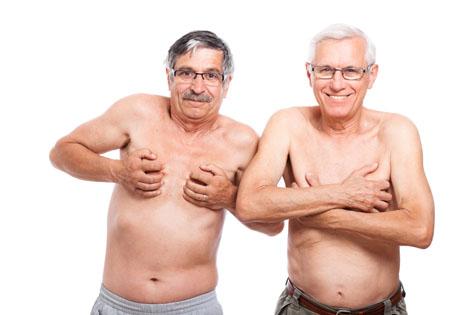- Newborn baby boys experience a higher level of oestrogen as they develop, and as the hormones pass from the placenta from mother to infant. The growth usually disappears within a couple of weeks after the birth of the infant.
- Puberty can see a growth in the hormone levels of boys. While testosterone is down in the child, the oestrogen levels can increase which causes the breast tissue to grow, resulting in gynaecomastia. Once hormone levels level out, the gynaecomastia can often resolve itself as the boy matures and testosterone levels increase.
- As men age and their testosterone levels decrease, they also tend to develop more body fat which can work to create a greater supply of oestrogen. Many older men who develop gynaecomastia will experience a combination of increased body fat and a drop in testosterone.
Top five causes of Gynaecomastia:Growing number of men are having ‘man boobs, or moobs’. What and How?
Date: November 26 2015

Ever heard of the term ‘man boobs’? Yes, you probably have, in a negative way - most likely. The medical term for ‘man boobs, or moobs’ - is gynaecomastia. The sad fact is that there is a growing number of men (and boys) who are experiencing a growth in the breast area. There is a rise in the number of young men who are opting for breast reduction surgery - and this has now surpassed many other kinds of cosmetic surgery that teens are requesting.
So what is the cause of gynaecomastia?
Hormone imbalances and obesity are a big part of what causes gynaecomastia, but let’s take a look at the top five reasons why boys and men experience a growth in their breast region, and how people can prevent it.
1. Hormone imbalances
Gynaecomastia is seen where there is a difference, or imbalance between the sex hormones - oestrogen and testosterone. While it’s natural for men to produce some oestrogen, some men with gynaecomastia experience a surge of much higher levels of oestrogen which then causes breast tissue to swell and grow. The cause of this kind of imbalance is unknown, but the ramifications of it are difficult for some men to endure as their breast tissue grows.
The imbalance of hormones can occur at different stages in life, and they are as follows:
2. Obesity
Another big cause of gynaecomastia is being overweight or having excess fat on the body. In many cases, gynaecomastia isn’t necessarily caused by being overweight, but it certainly increases the likelihood. If a male has fat under his skin, it will give the impression that he has enlarged breasts - but it may not be the same as the gynaecomastia condition. With a healthy diet and exercise, the man might see a reduction in the breast area.
3. Drug Use
Using drugs like anabolic steroids can contribute to a growth in the breast tissue of some males. It can also be a side effect from other drugs like anti-ulcer drugs that men will see a growth in the breast tissue. Alcohol can also be a factor in the growth of breast tissue that is indicative of gynaecomastia, and anyone who is using drugs or drinking heavily needs to be aware of this as a possibility.
4.Organ Failure and Disease
Men who have experienced organ failure or disease may be at a higher risk of developing gynaecomastia due to the change in the body.
5. Genetics
Some men will be at a greater risk of developing gynaecomastia due to there being a hereditary risk. Family history is a strong indicator of this condition.
Treatment of gynaecomastia
Men can undergo breast reduction surgery for gynaecomastia, and it’s typically a day procedure performed using liposuction technology. This effectively removes both fatty tissue and glandular tissue from the chest area. As a procedure, it’s a relatively simple one and something for men to consider if they suffer from gynaecomastia.
|
||||||||||||||||||||||







 Agree (0)
Agree (0) Disagree (
Disagree (







__small.png)










